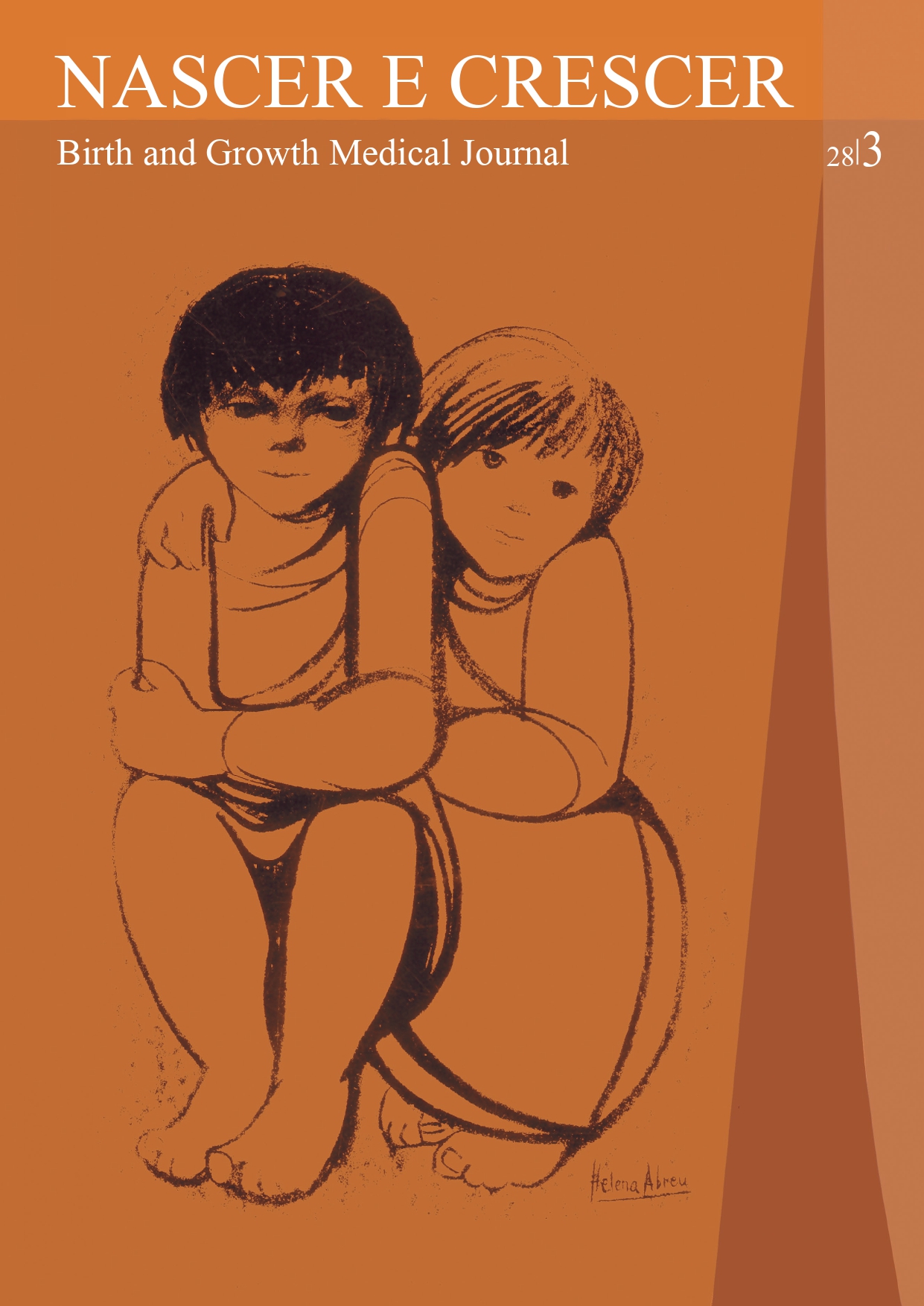Serum sickness-like reaction in pediatric age - experience of an Imunoalergology Unit
DOI:
https://doi.org/10.25753/BirthGrowthMJ.v28.i3.16677Keywords:
antibiotics, children, serum sickness-like reactionAbstract
Background: Serum sickness is a systemic reaction reported after administration of heterologous serum. It is clinically characterized by fever, skin lesions, arthralgia/arthritis, lymphadenopathy, and nephritis and by presence of immune complexes. Serum sickness-like reaction mimics serum sickness and its pathophysiology is not well understood. It is more common in pediatric age and often associated with drug administration. This study aimed to characterize serum sickness-like reaction cases evaluated at a Drug Allergy Clinic.
Material and methods: An analytical, retrospective, longitudinal study of a sample of 39 children (56% male) with diagnosis of serum sickness-like reaction evaluated at a Drug Allergy Clinic between January 2007 and December 2017 was performed.
Results: Children had an average of 4.8 years at the time of reaction. In most cases (97%), beta-lactam antibiotics were the suspected triggering drugs. On average, clinical manifestations developed 7.5 days after treatment start. Skin lesions developed in all patients, and arthralgia/arthritis in 92.3%. Fifteen percent of children were hospitalized. Penicillin-specific IgE was evaluated in 87% of patients, but only tested positive in two. Skin prick tests and intradermal tests were performed in 46% of cases and were positive in seven. Oral challenge test was performed in 26% of patients and was positive in three.
Conclusion: Serum sickness-like reaction is a rare and poorly understood entity. Diagnosis is essentially clinical, requiring a high index of suspicion. In the acute phase, usefulness of complementary tests lies mainly in the differential diagnosis with other diseases.
Downloads
References
2. Lawley TJ, Bielory L, Gascon P, Yancey KB, Young NS, Frank MM. A prospective clinical and immunologic analysis of patients with serum sickness. N Eng J Med 1984; 311: 1407-13.
3. Mark HW. Serum sickness and serum sickness-like reactions. July, 2018. (Accessed August 8, 2018). Available in: http://www.uptodate.com.
4. Barata LT. Alergias. In: Arosa FA, Cardoso EM, Pacheco FC, editors. Fundamentos de imunologia. 1º edição. Lisboa: Lidel; 2007. p. 257-78.
5. Shin H, Chang M. Drug eruptions in children. Curr Probl Pediatr 2001; 205-30.
6. Segal AR, Doherty KM, Leggott J, Zlotoff B. Cutaneous reactions to drugs in children. Pediatrics 2007; 120: 1082-96.
7. Yorulmaz A, Akin F, Sert A, Agir MA, Yilmaz R, Arslan S. Demographic and clinical characteristics of patients with serum sickness-like reaction. Clin Rheumatol 2018; 37: 1389-94.
8. Tatum AJ, Ditto AM, Patterson R. Severe serum sickness-like reaction to oral penicillin drugs: three case reports. Ann Allergy Asthma Immunol 2001; 86: 330-4.
9. Mathes EF, Gilliam AE. A four-year-old boy with fever, rash and arthritis. Semin Cutan Med Surg 2007; 26: 179-87.
10. Brucculeri M, Charlton M, Serur D. Serum sickness-like reaction associated with cefazolin. BMC Clinica Pharmacology 2006; 6: 1-3.
11. Vial T, Pont J, Pham E, Rabilloud M, Descotes J. Cefaclorassociated serum sickness-like disease: eight cases and review of the literature. Ann Pharmacotherapy 1992; 26: 910-4.
12. Lin B, Strehlow M. Serum-sickness-like reaction to amoxicilin. Ann Emerg Med 2007; 50: 350-9.
13. Barreia P, Gomes E. Doença do soro-like associada à administração de fármacos em idade pediátrica. Rev Port Imunoalergologia 2013; 21: 267-74.
14. Ferreira S, Ferreira S, Belo N, Estanqueiro P, Salgado M. Doença de Soro-like na criança. Saúde Infantil 2013; 35: 28-32.
15. Brockow K, Romano A, Blanca M, Ring J, Pichler W, Demoly P. General considerations for skin test procedures in the diagnosis of drug hypersensitivity. Allergy 2002; 57: 45-51.
16. Romano A , Blanca M, Torres MJ, Bircher A , Aberer W, Brockow K, et al. Diagnosis of nonimmediate reactions to β-lactam antibiotics. Allergy 2004; 59: 1153-60.
17. Aberer W, Bircher A, Romano A, Blanca M, Campi P, Fernandez J, et al. Drug provocation testing in the diagnosis of drug hypersensitivity reactions: general considerations. Allergy 2003;58: 854-63.
18. Demoly P, Adkinson NF, Brockow K, Castells M, Chiriac AM, Greenberger PA, et al. International Consensus on drug allergy. Allergy 2014; 69: 420-37.
19. Brockow K, Przybilla B, Aberer W, Bircher AJ, Brehler R, Dickel H, et al. Guideline for the diagnosis of drug hypersensitivity reactions. Allergo J Int. 2015; 24: 94-105.
Downloads
Published
How to Cite
Issue
Section
License
Copyright and Authors' Rights
All articles published in Nascer e Crescer - Birth and Growth Medical Journal are Open Access and comply with the requirements of funding agencies or academic institutions. For use by third parties, Nascer e Crescer - Birth and Growth Medical Journal adheres to the terms of the Creative Commons License "Attribution - Non-Commercial Use (CC-BY-NC)".
It is the author's responsibility to obtain permission to reproduce figures, tables, etc. from other publications.
Authors must submit a Conflict of Interest statement and an Authorship Form with the submission of the article. An e-mail will be sent to the corresponding author confirming receipt of the manuscript.
Authors are permitted to make their articles available in repositories at their home institutions, provided that they always indicate where the articles were published and adhere to the terms of the Creative Commons license.


